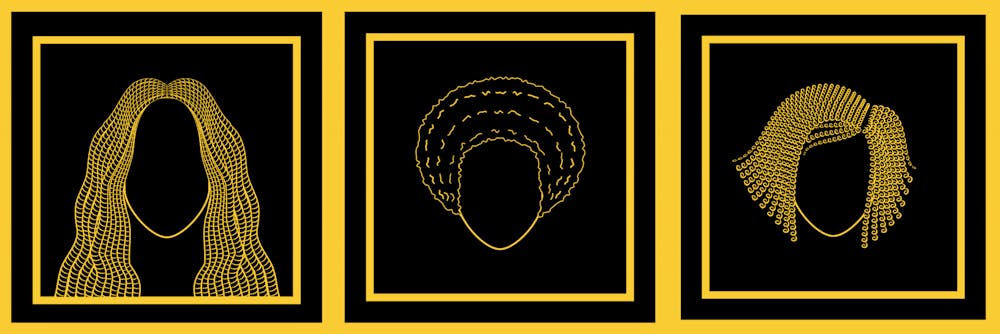How many times did the black girl in your class switch up her hairstyle last semester?
Isn’t it crazy how it was down her back on Friday, but then she came back on Monday with it shoulder length? What’s that all about?
Maybe you decided to compliment her on her drastic haircut, and she froze before she decided how to respond. Or maybe you asked how her hair grew out so long, and she stared at you for a long time.
Or, maybe she even said hi to you, and it took a while for you to register that it was her because her hair looked different from the last time you saw her.
For black women who frequently change their hairstyles, these situations happen all too often.
It happened to senior statistics major Alison Tuiyott recently when she came to class wearing long faux locs after previously wearing her hair naturally.
“[A classmate] comes over and is like, ‘That’s so interesting, how did your hair grow over the weekend?’” Tuiyott said. “I was gonna say something honest, but since everyone [is listening], let me just make a joke, ‘cause it’s like, surely this man will get it.”
“So I said, ‘I took all the hair from my body, and I braided them and put them into locs, then I put them on my head.’”
The classmate who questioned Tuiyott didn’t know if she was joking and didn’t laugh, Tuiyott explained.
“He was like, ‘Huh — for some reason, I don’t know if you’re telling me the truth or not.’”
Because Tuiyott answers these sorts of questions often, she said she’s come up with different responses. “Oh, I just don’t care anymore. [Sometimes I just] tell people to look up key terms. It saves a lot of time.”
Black women wear their hair in many different ways. “Protective styles” is the overarching term for hairstyles that are “low manipulation,” or styles that you can leave alone for one to six weeks after installation.
Enjoy what you're reading?
Signup for our newsletter
Some examples of these include cornrows, box braids and wigs.
“[Protective styles] allow your hair to grow and retain moisture,” said junior kinesiology major Taylor Wright. “They’re less damaging [than doing your hair everyday], so these styles are meant to help.”
Having go-to answers can save a lot of embarrassment and awkward situations for black women. Sophomore psychology and pre-medical studies major Dornu Biragbara knows what it’s likel.
“I don’t change [my hair] that often, but when I do, it comes off as a shock to other people,” she said.
One Monday last November, she went to her McCullogh-Hyde volunteer program as usual, but instead of wearing her normal wig, she wore her natural hair in a top bun.
“The nurses didn’t recognize me, [asking me] ‘What’s your name? Are you a new volunteer?’” she said. “No, I’ve been working here for two months!”
When white people do recognize her and compliment her hair, Biragbara said it’s not all bad.
“It’s positive, mostly. It’s just annoying when I get the ‘I didn’t even recognize you!’ or when you start touching on it or asking too many questions,” she said.
Sophomore speech pathology and audiology major Kaleigh Hollyday said that, as a white person, it’s sometimes difficult to figure out how to properly compliment a black classmate’s hair.
“I think a lot of times with ‘politically correct’ things I’m trying to be good, and I just end up being offensive,” Hollyday said. “I don’t want to offend anyone when I’m trying to give a compliment.”
“Every time I go to do it, I’m like, ‘is it okay to compliment on that?’ I always get stressed about it, so I usually refrain,” she added.
But Wright said she doesn’t get offended by comments if they come from a place of genuine interest.
“Questions aren’t racist if they truly don’t know [about black hair],” she said. “Confusion can be eliminated if you just inform people.”
Because Wright’s hair is so long, she said a lot of people ask her if her hair is real or a wig. “I’ll answer questions and tell people why and how I grew out my hair.”
For people like Hollyday, who grew up in predominantly white communities, asking questions about different black hairstyles is another type of education they have received at Miami.
“There was legit no ethnic diversity in my town whatsoever, so when I got here, I was really unaware of all the differences,” she said. “Sponging was new, the difference between a wig and a weave, everything was new but really interesting.”
The reason why black women change their hairstyles so frequently is different for everyone.
“Every three weeks I get a brand new feel. It’s a new me,” Tuiyott said. “Even with wigs and stuff, I like to play with new personalities. I get to have fun and be myself in all sorts of ways.”
Biragbara agreed, adding that different styles offer different benefits to black hair.
“It helps your hair grow,” she said. “Also, because it’s [winter], we need more hydration to maintain length and thickness in the winter.”
“It is a full-time job,” Wright added. “It requires 10 times more maintenance than straight, non-kinky hair.”
Hollyday said she has noticed a cultural shift in how other races view black hair.
“There’s definitely a shift right now in terms of appreciating how beautiful black hair can be in its own right,” she said, “without changing to be more like white hair.”
“[We wear these styles] not to assimilate, necessarily; it’s just because it’s easier for us,” Biragbara said. “And we like it; we like to be a different person every week. We have that choice.”




